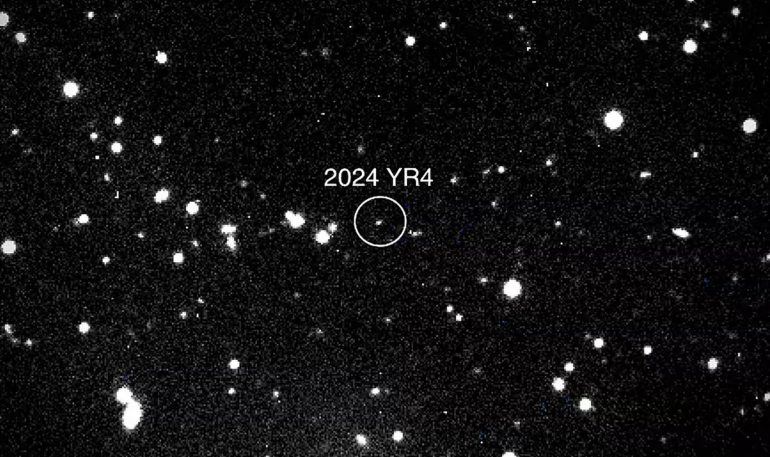“An asteroid might hit the Earth.”
It sounds like a line straight from a doomsday film, something said by someone who’s watched one too many sci-fi movies. After all, when was the last time an asteroid posed a real threat? Turns out, very recently. Twelve years ago, an asteroid entered the atmosphere and exploded mid-air over Chelyabinsk, Russia. The event created a shockwave so powerful that, according to Kate Howells in The Planetary Society, it was estimated to have released the same amount of energy as 500 kilotons of TNT, “around 30 times more energy than the atomic bomb detonated at Hiroshima.” Most of it was absorbed by the atmosphere, but the incident still injured thousands of people. However, asteroids aren’t just a thing of the past: enter 2024 YR4.
2024 YR4 was discovered in December 2024 at the El Sauce Observatory in Chile by the Asteroid Terrestrial-impact Last Alert System (ATLAS). According to CBS, the asteroid is estimated to be between 130 and 200 feet wide. On December 31, 2024, it quickly gained attention after rising to the top of the automated Sentry list, run by NASA, which tracks any asteroids with a “non-zero probability” of impacting the Earth in the future. On the same day, Kelly Fast, Acting Planetary Defense Officer at NASA, stated, “You get observations, they drop off again. This one looked like it had the potential to stick around”.
Astronomers based these claims on initial observations taken after the asteroid’s discovery. While the asteroid’s exact trajectory could only be estimated, scientists predicted there would be a slim chance it would be Earth-bound when it passes within 66,000 miles of Earth on December 22, 2032. By January 29, NASA’s analysis of observations gave the asteroid over a 1% chance of impacting the Earth. Around a week later, on February 6th, the probability had increased to 2.3%.
NASA’s Center for Near-Earth Object Studies at the Jet Propulsion Laboratory in California later incorporated new observations reported to the Minor Planet Center, increasing the probability to 3.1% on February 18th. According to NASA’s blog, it “is the highest impact probability NASA has ever recorded for an object of this size or larger”. This increase caused the asteroid to shoot up on the Torino Scale, a ten-level system developed in 1999 to “communicate to the public the risks that near-Earth asteroids and other cosmic objects may pose to the planet.” YR4 landed on Level 3, the second time any space rock has been featured this high. A Level 3 threat placed it in the yellow intermediate zone, meaning that there is a 1% or greater chance of a collision resulting in local destruction. The last time an asteroid reached these levels was in 2004, when Apophis received a Level 4 categorization. While it had a lower chance of impact with Earth, it was larger and could have caused regional destruction. Apophis has now been demoted to 0 on the Torino Scale, according to Popular Mechanics.
However, YR4 soon met a fate similar to Apophis after additional observations collected overnight on February 19th reduced the chance to 1.5%. The trend of a decreased chance of an impact with Earth continued, culminating in a new report on February 24th. The result was a 0.004% chance of a collision with Earth and a 1.7% chance with the Moon. At this point, NASA officially concluded there is “no significant potential for this asteroid to impact our planet for the next century.” NASA cannot declare a 0% chance of impact until the entire range of potential locations of the asteroid moves away.
In less than two months, YR4 made headlines for a history-making possibility to hit the Earth, but fell to a near-zero chance. So why did YR4’s trajectory continuously change?
It comes down to the observations and data that scientists have available. When the asteroid was first detected, scientists had little information about it to determine a definitive path. This results in higher chances of an impact with Earth, as the chance of collision cannot be ruled out yet. In fact, varying predictions, including those that show relatively high chances of an impact with Earth, are often expected and common. According to astrologist Richard Binzel, the creator of the Torino Scale, “the amount of information we have to track this asteroid is like trying to figure out where a fly ball will land at the crack of the bat”. He told NBC that changes like the ones seen for YR4 are “perfectly normal”.
In the case of YR4, the moon heavily obstructed data collection, contributing to the uncertainty about its trajectory. According to NASA, ground telescopes need darkness to see asteroids. However, light created by a full moon obstructs the faint points of the asteroid, making the sky too bright and preventing observations of YR4. After the full moon in February had subsided, astronomers “resumed” observations of YR4.
The observations received by NASA helped refine the models of YR4’s orbit, allowing estimates of the asteroid’s trajectory to be created. Using their estimates, NASA scientists modeled scenarios for December 22, 2032, determining the likelihood of impact with Earth. While NASA has stuck with its 0.004% figure, it is still monitoring the asteroid, including with the James Webb Space Telescope.
Despite the attention YR4 gained over the past few months, most Greeley students have not heard about it or its rollercoaster of changing impact predictions. However, those who had found it fascinating. Violet C., a freshman at Greeley, expressed curiosity about how NASA continues to refine probability calculations, while others shared concerns about the potential damage YR4 could cause. One student wondered, “If the collision occurred, what would be done to try and stop it?” Others saw YR4 as an opportunity for scientific study, with one suggesting that if it passes close enough, it should be analyzed rather than disrupted.
YR4 presented a unique astronomical story: the highest chance an asteroid had of colliding with the Earth in years. Ultimately, the asteroid mirrored past trends: an increase in probability due to a lack of observation before a drop to a near-zero impact chance. YR4 was deemed a “city-killer,” with the capability of wiping out an entire city and its suburbs. However, like the asteroid over Chelyabinsk, it would likely have exploded mid-air. YR4 serves as a notable reminder of the struggles with the variance in asteroid trajectories and how it affects the information given to the general public. Binzel summarizes this best when he states, “It’s a bit like being between a rock and a hard place because we want to report what we know to maintain public trust, but we also don’t want to raise any unnecessary anxiety.” His statement begs the question, did YR4 garner unnecessary attention, or does the asteroid rightfully deserve its notability?







